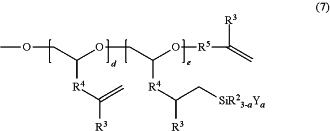| CPC C08G 65/331 (2013.01) [C08F 220/1804 (2020.02); C08F 224/00 (2013.01); C08G 65/12 (2013.01); C08G 65/336 (2013.01); C08K 5/5419 (2013.01); C08K 5/5425 (2013.01); C08K 5/56 (2013.01); C08L 71/02 (2013.01); C08L 101/02 (2013.01); C08L 101/10 (2013.01); C08G 2150/00 (2013.01); C08G 2170/00 (2013.01); C08G 2190/00 (2013.01); C08G 2650/06 (2013.01); C08G 2650/22 (2013.01)] | 16 Claims |
|
1. A polyoxyalkylene polymer (A) comprising a main chain structure of a polyoxyalkylene and terminal structures bonded to ends of the main chain structure, wherein the main chain structure is a polymer main chain composed of oxyalkylene repeating units and the terminal structures are moieties that do not contain the oxyalkylene repeating unit and that are bonded to ends of the main chain structure;
the terminal structures are represented by the formula (6):
 or the formula (7):
 wherein R2 represents a substituted or unsubstituted monovalent hydrocarbon group having 1 to 20 carbon atoms or a triorganosiloxy group represented by (R′)3SiO— and R′ represents a substituted or unsubstituted monovalent hydrocarbon group having 1 to 20 carbon atoms;
Y represents a hydroxy group or a hydrolyzable group;
“a” represents 1, 2, or 3;
R3 represents hydrogen, a substituted or unsubstituted alkyl group having 1 to 10 carbon atoms, a substituted or unsubstituted aryl group having 6 to 10 carbon atoms, or a substituted or unsubstituted aralkyl group having 7 to 10 carbon atoms;
R4 represents a direct bond or a divalent organic group having 1 to 6 carbon atoms and optionally an oxygen atom;
R5 represents a direct bond or a divalent organic group having 1 to 6 carbon atoms and optionally an oxygen atom;
“d” and “e” each represent an integer of 0 or more, and the sum of “d” and “e” is more than 0 on average per terminal structure;
at least one of a terminal olefin group present in the formula (6) or (7) is optionally replaced by an internal olefin group;
the order in which “d” terminal olefin group-containing units and “e” hydrolyzable silyl group-containing units are bonded is not limited to those shown in the formula (6) and (7);
the total number of hydrolyzable silyl, terminal olefin, and internal olefin groups is more than 1.0 on average per terminal structure; and
the ratio of the number of moles of the hydrolyzable silyl groups to the total number of moles of the hydrolyzable silyl, terminal olefin, and internal olefin groups is from 0.3 to 0.7.
|